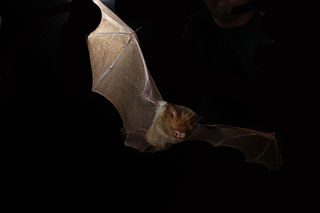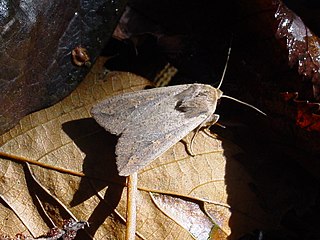
Lepidoptera is an order of insects that includes butterflies and moths. About 180,000 species of the Lepidoptera are described, in 126 families and 46 superfamilies, 10 percent of the total described species of living organisms. It is one of the most widespread and widely recognizable insect orders in the world. The Lepidoptera show many variations of the basic body structure that have evolved to gain advantages in lifestyle and distribution. Recent estimates suggest the order may have more species than earlier thought, and is among the four most species-rich orders, along with the Hymenoptera, Diptera, and Coleoptera.

Echolocation, also called bio sonar, is a biological sonar used by several animal species. Echolocating animals emit calls out to the environment and listen to the echoes of those calls that return from various objects near them. They use these echoes to locate and identify the objects. Echolocation is used for navigation, foraging, and hunting in various environments.

The Noctuidae, commonly known as owlet moths, cutworms or armyworms, are a family of moths. They are considered the most controversial family in the superfamily Noctuoidea because many of the clades are constantly changing, along with the other families of the Noctuoidea. It was considered the largest family in Lepidoptera for a long time, but after regrouping Lymantriinae, Catocalinae and Calpinae within the family Erebidae, the latter holds this title now. Currently, Noctuidae is the second largest family in Noctuoidea, with about 1,089 genera and 11,772 species. This classification is still contingent, as more changes continue to appear between Noctuidae and Erebidae.

The Arctiinae are a large and diverse subfamily of moths with around 11,000 species found all over the world, including 6,000 neotropical species. This subfamily includes the groups commonly known as tiger moths, which usually have bright colours, footmen, which are usually much drabber, lichen moths, and wasp moths. Many species have "hairy" caterpillars that are popularly known as woolly bears or woolly worms. The scientific name Arctiinae refers to this hairiness. Some species within the Arctiinae have the word "tussock"' in their common names because they have been misidentified as members of the Lymantriinae subfamily based on the characteristics of the larvae.
Johnston's organ is a collection of sensory cells found in the pedicel of the antennae in the class Insecta. Johnston's organ detects motion in the flagellum. It consists of scolopidia arrayed in a bowl shape, each of which contains a mechanosensory chordotonal neuron. The number of scolopidia varies between species. In homopterans, the Johnston's organs contain 25 - 79 scolopidia. The presence of Johnston's organ is a defining characteristic which separates the class Insecta from the other hexapods belonging to the group Entognatha. Johnston's organ was named after the physician Christopher Johnston, father of the physician and Assyriologist Christopher Johnston.
Chordotonal organs are stretch receptor organs found only in insects and crustaceans. They are located at most joints and are made up of clusters of scolopidia that either directly or indirectly connect two joints and sense their movements relative to one another. They can have both extero- and proprioceptive functions, for example sensing auditory stimuli or leg movement. The word was coined by Vitus Graber in 1882, though he interpreted them as being stretched between two points like a string, sensing vibrations through resonance.

Cycnia tenera, the dogbane tiger moth or delicate cycnia, is a moth in the family Erebidae. It occurs throughout North America, from southern British Columbia to Nova Scotia southwards to Arizona and Florida. The species is distasteful and there is evidence that it emits aposematic ultrasound signals; these may also jam bat echolocation, as the functions are not mutually exclusive.

The Mauritian tomb bat is a species of sac-winged bat in the family Emballonuridae that is found in central and southern Africa and Madagascar. It was discovered in 1818 by Étienne Geoffroy Saint-Hilaire, and is characterized by an all-white ventral surface, grizzled dorsal coloration, and conical face. It has exceptionally good eyesight, a trait which is common in old world bats and enables it to find roosting locations. It has adapted itself to a wide range of habitats including subarid scrub to semi-tropical savanna and can be found throughout much of Africa south of the Sahara, including many of the surrounding islands. They often seek out refuge in cool dry areas. Mauritian tomb bats help control pest populations, including insects that carry human diseases. These bats tend to be nocturnal hunters and their normal prey consists of moths, butterflies, and termites. Not prone to large-scale roosting, T. mauritianus is most often spotted on the sides of buildings or on the trunks of trees in groups of around five individuals. They breed on average once or twice a year and rear usually one pup, though twins are occasionally reported. They usually deposit their hungry offspring in areas where they can feed ferociously, most often in berry bushes. This species is listed as least concern on the IUCN Red List due their wide distribution and stable population.

The diadem leaf-nosed bat or diadem roundleaf bat is one of the most widespread species of bat in the family Hipposideridae. It is probably most closely related to Hipposideros demissus from Makira and to Hipposideros inornatus from the Northern Territory in Australia. Hipposideros diadema is found in Australia, Indonesia, Malaysia, Myanmar, the Philippines, Thailand, and Vietnam.

Waterhouse's leaf-nosed bat is a species of big-eared bat in the family Phyllostomidae. It is found in the Greater Antilles in the Cayman Islands, Cuba, Hispaniola and Jamaica, as well as Mexico south to Guatemala.

Mehely's horseshoe bat is a species of insectivorous bat in the family Rhinolophidae found in Southern Europe and parts of the Middle East. It is distributed in a narrow band around the Mediterranean Sea from North-Western Africa across Portugal, Spain, the Balearics, southern France, Sardinia, Sicily and the Balkan Peninsula to Asia Minor.

Mythimna unipuncta, the true armyworm moth, white-speck moth, common armyworm or rice armyworm, is a nocturnal agricultural pest belonging to the family Noctuidae. This moth is also commonly referred to by the scientific name Pseudaletia unipuncta. The species was first described by Adrian Hardy Haworth in 1809. Mythimna unipuncta is found in the Americas and in parts of Europe, Africa and Asia. Its original distribution is North and South America. It has been introduced to other places from there. They are known as armyworms because the caterpillars move in lines as a massive group, like an army, from field to field, damaging crops.

The tymbal is the corrugated exoskeletal structure used to produce sounds in insects. In male cicadas, the tymbals are membranes in the abdomen, responsible for the characteristic sound produced by the insect. In tiger moths, the tymbals are modified regions of the thorax, and produce high-frequency clicks. In lesser wax moths the left and right tymbals emit high frequency pulses that are used as mating calls.

Bats are mammals of the order Chiroptera. With their forelimbs adapted as wings, they are the only mammals capable of true and sustained flight. Bats are more agile in flight than most birds, flying with their very long spread-out digits covered with a thin membrane or patagium. The smallest bat, and arguably the smallest extant mammal, is Kitti's hog-nosed bat, which is 29–34 millimetres in length, 150 mm (6 in) across the wings and 2–2.6 g in mass. The largest bats are the flying foxes, with the giant golden-crowned flying fox reaching a weight of 1.6 kg and having a wingspan of 1.7 m.

Sterrhinae is a large subfamily of geometer moths with some 3,000 described species, with more than half belonging to the taxonomically difficult, very diverse genera, Idaea and Scopula. This subfamily was described by Edward Meyrick in 1892. They are the most diverse in the tropics with the number of species decreasing with increasing latitude and elevation.

The external morphology of Lepidoptera is the physiological structure of the bodies of insects belonging to the order Lepidoptera, also known as butterflies and moths. Lepidoptera are distinguished from other orders by the presence of scales on the external parts of the body and appendages, especially the wings. Butterflies and moths vary in size from microlepidoptera only a few millimetres long, to a wingspan of many inches such as the Atlas moth. Comprising over 160,000 described species, the Lepidoptera possess variations of the basic body structure which has evolved to gain advantages in adaptation and distribution.
Ultrasound avoidance is an escape or avoidance reflex displayed by certain animal species that are preyed upon by echolocating predators. Ultrasound avoidance is known for several groups of insects that have independently evolved mechanisms for ultrasonic hearing. Insects have evolved a variety of ultrasound-sensitive ears based upon a vibrating tympanic membrane tuned to sense the bat's echolocating calls. The ultrasonic hearing is coupled to a motor response that causes evasion of the bat during flight.

A scolopidium is the fundamental unit of a mechanoreceptor organ in insects. It is a composition of three cells: a scolopale cap cell which caps the scolopale cell, and a bipolar sensory nerve cell.
Ostrinia scapulalis, the adzuki bean borer or adzuki bean worm, is a species of moth in the family Crambidae. It was described by Francis Walker in 1859. It is one of 20 moths in the genus Ostrinia and is of Eurasian origin. The larvae have a gray mid-dorsal line and can be light pink or beige. The adult adzuki bean borer has a yellowish-brown forewing with jagged lines and variable darker shading, with a wingspan that ranges from 20 to 32 mm. The moths of this species are nocturnal and tend to be attracted to light.
Echolocation systems of animals, like human radar systems, are susceptible to interference known as echolocation jamming or sonar jamming. Jamming occurs when non-target sounds interfere with target echoes. Jamming can be purposeful or inadvertent, and can be caused by the echolocation system itself, other echolocating animals, prey, or humans. Echolocating animals have evolved to minimize jamming, however; echolocation avoidance behaviors are not always successful.
















